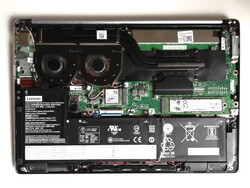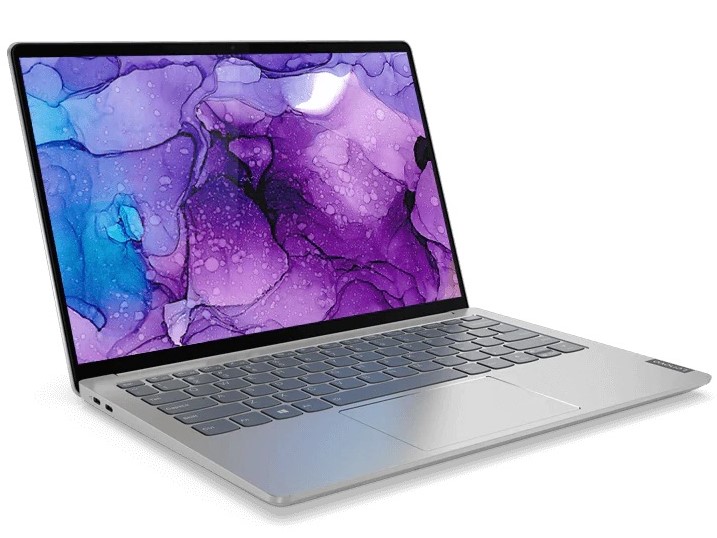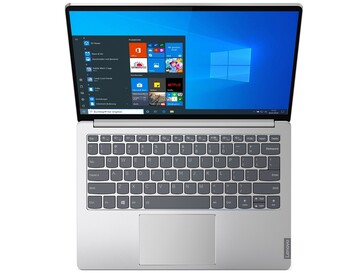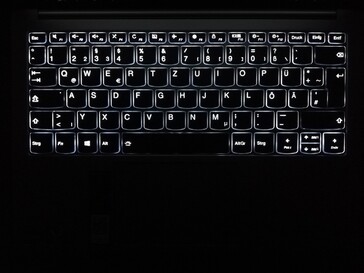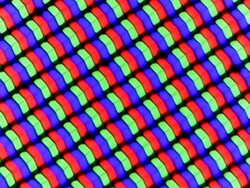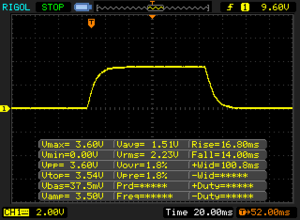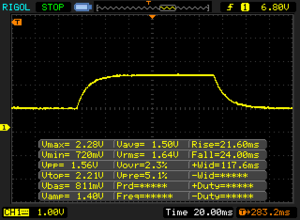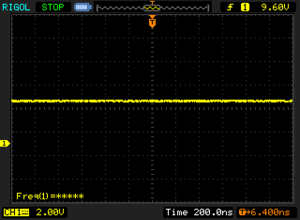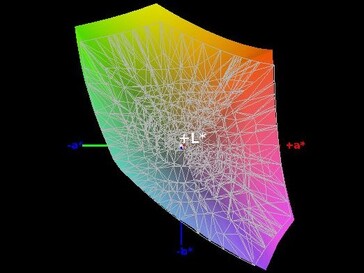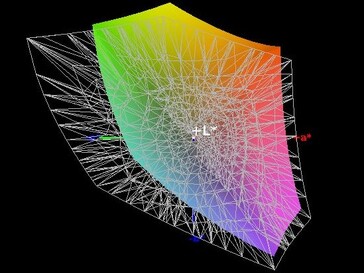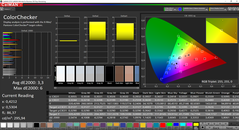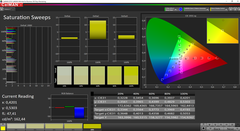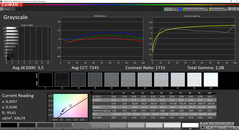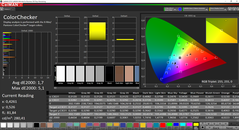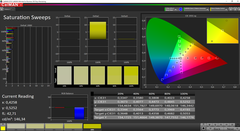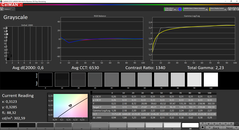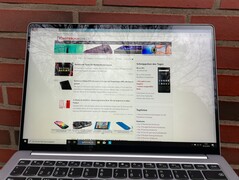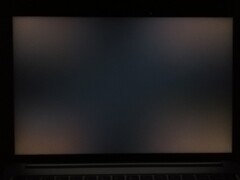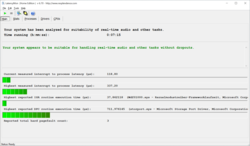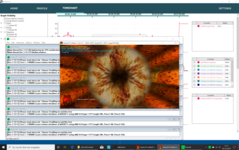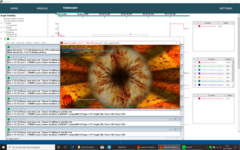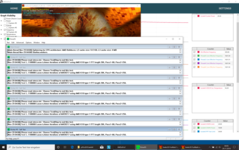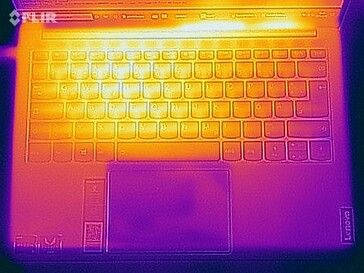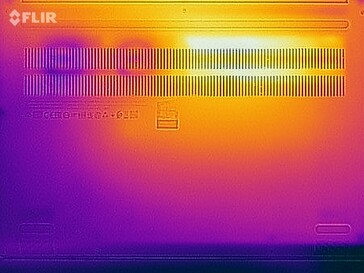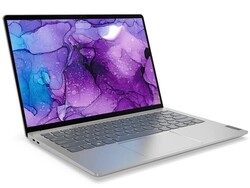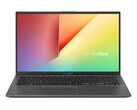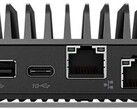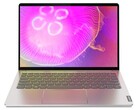Lenovo IdeaPad S540-13API Laptop in Review: Slim Ryzen Companion with Long Battery Life

Lenovo's IdeaPad series laptop come in various configurations and display sizes. We recently reviewed the Lenovo IdeaPad S540-15IWL, for example, which is equipped with a 15.6-inch screen and Intel hardware. Its build quality and performance were solid overall. The display left something to be desired, however. Furthermore, the AMD variant came out ahead in a direct comparison.
Our test model of the IdeaPad S540-13API is AMD-based as well. A Ryzen 5 3550H and 16 GB of RAM make for a responsive system. Additionally, the integrated graphics unit AMD Radeon RX Vega 8 and a 512-GB SSD are built-in. For less than $1,000, the included hardware is decent and able to compete against the competitors listed below. Underneath every table, additional laptops from our database can be added for comparison.
Rating | Date | Model | Weight | Height | Size | Resolution | Best Price |
|---|---|---|---|---|---|---|---|
| 84.9 % | 12/2019 | Lenovo IdeaPad S540-13API R5 3550H, Vega 8 | 1.3 kg | 16 mm | 13.30" | 2560x1600 | |
| 83.9 % | 11/2019 | Acer TravelMate X514-51-511Q i5-8265U, UHD Graphics 620 | 980 g | 15 mm | 14.00" | 1920x1080 | |
| 86 % | 07/2019 | Lenovo ThinkBook 13s-20R90071GE i5-8265U, UHD Graphics 620 | 1.3 kg | 15.9 mm | 13.30" | 1920x1080 | |
| 82.7 % | 11/2019 | Acer Swift 3 SF314-41-R8HZ R5 3500U, Vega 8 | 1.5 kg | 18 mm | 14.00" | 1920x1080 | |
| 83.7 % | 09/2019 | Asus VivoBook 14 X403FA i5-8265U, UHD Graphics 620 | 1.3 kg | 16.5 mm | 14.00" | 1920x1080 |
Case & Connectivity - Robust Aluminum and Poor Serviceability
In terms of the design, Lenovo has opted for a subtle look that does not look cheap thanks to the matte aluminum surfaces. The compact system is well-built and there are no uneven clearances or similar flaws. The hinge can be opened to a maximum angle of about 140 degrees and firmly holds the display in place. The speakers are located on the bottom of the slightly angled front edge of the laptop. The bottom plate can be easily removed after all of the screws have been loosened. Subsequently, users have access to the fans, SSD and the Wi-Fi module. However, swapping or upgrading the RAM is not possible.
The IdeaPad S540-13API does not offer a very wide port selection and there is, for example, no HDMI port. With an appropriate adapter, an external display can still be connected via the two USB-C ports, both of which can also be used to charge the ultra-mobile laptop. As for wireless connectivity, Bluetooth 5.0 and Wi-Fi 6 with the fast 802.11ac standard are available. Despite the integrated 2x2-MIMO antenna, we only measured average transfer rates of 501 MB/s for receiving and a fairly mediocre 447 MB/s when sending data in our Wi-Fi test.
Input Devices - Good Lenovo Keyboard with Somewhat Small Keys
The keyboard of the Lenovo IdeaPad S540 is well-suited to larger typing tasks. It has a good feedback and a slightly spongy actuation point. For large hands, the keys may be slightly too small, particularly since there is not a lot of space between the keys. Our test model also has a two-stage white backlight, which can be adjusted according to your own preferences.
A ClickPad serves as the mouse substitute. The surface is very smooth and allows for precisely navigating the system. The touchpad responds well to clicks by tapping. Slight pressure on the bottom edge results in a left or right click that is confirmed by a soft acoustic feedback.
Display - IdeaPad S540-13API with Glossy Screen
The display of the Lenovo IdeaPad S540 is based on a 13.3-inch IPS panel with a native resolution of 2,560x1,600 pixels. Since the display is glossy, strong reflections are inevitable. At 314 cd/m², the average brightness is sufficiently high and is the highest value in our comparison. Similarly, our test model places first in terms of illumination with its very good result of 94 percent. Our measurements were also able to confirm that PWM is not being used to control the brightness level.
Lenovo does not offer other display options for the IdeaPad S540.
| |||||||||||||||||||||||||
Brightness Distribution: 94 %
Center on Battery: 322 cd/m²
Contrast: 1689:1 (Black: 0.19 cd/m²)
ΔE Color 3.3 | 0.5-29.43 Ø5, calibrated: 1.7
ΔE Greyscale 3.5 | 0.57-98 Ø5.3
98.4% sRGB (Argyll 1.6.3 3D)
64.5% AdobeRGB 1998 (Argyll 1.6.3 3D)
72.6% AdobeRGB 1998 (Argyll 2.2.0 3D)
98.6% sRGB (Argyll 2.2.0 3D)
73.4% Display P3 (Argyll 2.2.0 3D)
Gamma: 2.08
| Lenovo IdeaPad S540-13API CSOT T3 MND307DA1-2, IPS, 2560x1600, 13.30 | Acer TravelMate X514-51-511Q Chi mei CMN14D5, IPS, 1920x1080, 14.00 | Lenovo ThinkBook 13s-20R90071GE N133HCE-EN2, a-Si IPS LED, 1920x1080, 13.30 | Acer Swift 3 SF314-41-R8HZ Chi Mei N140HCA-EAC, IPS, 1920x1080, 14.00 | Asus VivoBook 14 X403FA Chi Mei N140HCA-EAC, IPS, 1920x1080, 14.00 | |
|---|---|---|---|---|---|
| Display | -5% | -4% | -41% | -41% | |
| Display P3 Coverage | 73.4 | 67 -9% | 67 -9% | 41.43 -44% | 40.85 -44% |
| sRGB Coverage | 98.6 | 98.9 0% | 99.1 1% | 61.8 -37% | 61.1 -38% |
| AdobeRGB 1998 Coverage | 72.6 | 68.6 -6% | 69.2 -5% | 42.85 -41% | 42.25 -42% |
| Response Times | 12% | 9% | 15% | 12% | |
| Response Time Grey 50% / Grey 80% * | 45.6 ? | 40 ? 12% | 40.4 ? 11% | 38 ? 17% | 40.8 ? 11% |
| Response Time Black / White * | 30.8 ? | 27 ? 12% | 28.8 ? 6% | 27 ? 12% | 27.2 ? 12% |
| PWM Frequency | 250 ? | 25000 ? | 250 ? | 24510 ? | |
| Screen | -4% | -1% | -53% | -59% | |
| Brightness middle | 321 | 295 -8% | 319 -1% | 233 -27% | 250 -22% |
| Brightness | 314 | 276 -12% | 309 -2% | 219 -30% | 236 -25% |
| Brightness Distribution | 94 | 82 -13% | 92 -2% | 75 -20% | 78 -17% |
| Black Level * | 0.19 | 0.215 -13% | 0.28 -47% | 0.14 26% | 0.27 -42% |
| Contrast | 1689 | 1372 -19% | 1139 -33% | 1664 -1% | 926 -45% |
| Colorchecker dE 2000 * | 3.3 | 2.6 21% | 2.4 27% | 5.9 -79% | 5 -52% |
| Colorchecker dE 2000 max. * | 6 | 5.6 7% | 6.3 -5% | 22.8 -280% | 20.7 -245% |
| Colorchecker dE 2000 calibrated * | 1.7 | 0.6 65% | 4.3 -153% | ||
| Greyscale dE 2000 * | 3.5 | 3.4 3% | 3.8 -9% | 4.8 -37% | 2.4 31% |
| Gamma | 2.08 106% | 2.08 106% | 2.16 102% | 2.06 107% | 2.05 107% |
| CCT | 7245 90% | 7192 90% | 7335 89% | 6589 99% | 6697 97% |
| Color Space (Percent of AdobeRGB 1998) | 64.5 | 63 -2% | 63.5 -2% | 39 -40% | 38.9 -40% |
| Color Space (Percent of sRGB) | 98.4 | 99 1% | 99.1 1% | 62 -37% | 61 -38% |
| Total Average (Program / Settings) | 1% /
-2% | 1% /
-0% | -26% /
-41% | -29% /
-47% |
* ... smaller is better
Display Response Times
| ↔ Response Time Black to White | ||
|---|---|---|
| 30.8 ms ... rise ↗ and fall ↘ combined | ↗ 16.8 ms rise | |
| ↘ 14 ms fall | ||
| The screen shows slow response rates in our tests and will be unsatisfactory for gamers. In comparison, all tested devices range from 0.1 (minimum) to 240 (maximum) ms. » 81 % of all devices are better. This means that the measured response time is worse than the average of all tested devices (21.5 ms). | ||
| ↔ Response Time 50% Grey to 80% Grey | ||
| 45.6 ms ... rise ↗ and fall ↘ combined | ↗ 21.6 ms rise | |
| ↘ 24 ms fall | ||
| The screen shows slow response rates in our tests and will be unsatisfactory for gamers. In comparison, all tested devices range from 0.2 (minimum) to 636 (maximum) ms. » 75 % of all devices are better. This means that the measured response time is worse than the average of all tested devices (33.7 ms). | ||
Screen Flickering / PWM (Pulse-Width Modulation)
| Screen flickering / PWM not detected | |||
In comparison: 53 % of all tested devices do not use PWM to dim the display. If PWM was detected, an average of 17900 (minimum: 5 - maximum: 3846000) Hz was measured. | |||
Our measurements reveal the IdeaPad S540-13API's good contrast ratio of 1,689:1 and a very good black value of only 0.19 cd/m². As a result, colors are distinct from one another and black areas appear deep and rich. With a color space coverage of 98.4 percent (sRGB) and 64.5 percent (AdobeRGB), the display of the Lenovo laptop does not have to shy away from the competition either.
Furthermore, the CalMan analysis shows the display to be very color accurate with an only slightly increased blue portion ex-factory. However, our calibration attempt results in an even more accurate display. Our ICC profile is linked above next to the display illumination graphic.
Due to the glossy display, the IdeaPad S540 is not well-suited for outdoor use. On cloudy days, the display shows reflections of objects in the environment even under shade. Consequentially, users should remain indoors with the laptop - at the very least during summer. The installed IPS panel has very good viewing angles, which prevent the screen's content and its colors from becoming distorted.
Performance - Higher Continuous Performance Thanks to Ryzen 5 3550H
Lenovo has equipped our IdeaPad S540-13API test device with an AMD Ryzen 5 3550H, which comes with an integrated Radeon RX Vega 8 graphics unit, as well as 16 GB of RAM and a 512-GB SSD. Thus, the small laptop is suitable for various office tasks and more than capable of completing simple image editing tasks. While 16 GB of RAM is already the maximum amount of system memory that can be configured, users may also equip the IdeaPad S540 with a Ryzen 7 APU and up to a 1-TB SSD.
Lenovo's Vantage app allows for selecting energy settings that are independent from Windows. All benchmarks were performed using the "intelligent cooling" profile. When enabling the "high performance" profile, the benchmarks produce similar results and the only difference was that there was some quiet fan noise even while idling.
Processor
The AMD Ryzen 5 3550H is a four-core CPU that is able to process up to 8 threads simultaneously. While the architecture it is based on is similar to that of the AMD Ryzen 5 3500U, it has a higher TDP of 35 watts instead of just 18 watts. This hints at a better long-term performance, although the performance level ultimately depends on the effectiveness of the cooling solution. With a base clock of 2.1 GHz and a Turbo Boost frequency of 3.7 GHz, the clock speeds are identical to the Ryzen 5 3500U.
In our Cinebench R15 loop test, the AMD Ryzen 5 3550H's initial peak results are not unlike those of the Acer Swift 3 SF314, although here, the performance decreases by only 7 percent over time. Thus, users can indeed expect a higher performance than with the Ryzen 5 3500U over longer periods of time.
In our individual Cinebench R15 tests, the Lenovo IdeaPad S540-13API only achieves average results. While the laptop only places second to last in our comparison when it comes to the single-core test, the result is still above average compared to other devices with the same CPU. The multi-core score is only slightly lower than that of the Ryzen 5 3500U inside the Acer Swift 3 SF314. In other laptops, the Ryzen 5 3550H achieves up to 13 percent better results.
In battery mode, the IdeaPad S540 reaches a Cinebench R15 multi-core score of 570 points.
System Performance
In our PCMark 10 test, which evaluates system performance, the Lenovo Legion S540-13API claims first place overall. However, it tends to fall behind slightly compared to the Acer Swift 3 SF314-41 in individual disciplines. Daily use is a breeze with the small 13-inch laptop. There is no stuttering and both the operating system as well as applications load quickly.
More comparisons and the test results of other laptops can be found on our dedicated CPU benchmark page.
Storage Solution
Lenovo has installed a 512-GB Samsung SSD in our test model. In our benchmarks, it achieves very fast read and write speeds and places first in our comparison. In practice, the good scores also result in very low access times and no noticeable delays.
The test results of other storage solutions can be found in our HDD/SSD table.
| Lenovo IdeaPad S540-13API Samsung SSD PM981 MZVLB512HAJQ | Acer TravelMate X514-51-511Q Kingston RBUSNS8154P3256GJ1 | Lenovo ThinkBook 13s-20R90071GE SK hynix BC501 HFM512GDHTNG-8310A | Acer Swift 3 SF314-41-R8HZ WDC PC SN520 SDAPNUW-512G | Asus VivoBook 14 X403FA Intel SSD 660p SSDPEKNW512G8 | Average Samsung SSD PM981 MZVLB512HAJQ | Average of class Subnotebook | |
|---|---|---|---|---|---|---|---|
| CrystalDiskMark 5.2 / 6 | -19% | -29% | -25% | -19% | -4% | 30% | |
| Write 4K | 133.9 | 122.3 -9% | 89.3 -33% | 134.3 0% | 130.8 -2% | 126.7 ? -5% | 154.9 ? 16% |
| Read 4K | 44.98 | 45.51 1% | 37.4 -17% | 43.56 -3% | 55.1 22% | 44 ? -2% | 65.7 ? 46% |
| Write Seq | 2730 | 667 -76% | 608 -78% | 1434 -47% | 962 -65% | 1617 ? -41% | 2466 ? -10% |
| Read Seq | 2403 | 713 -70% | 1019 -58% | 1448 -40% | 1634 -32% | 1716 ? -29% | 2627 ? 9% |
| Write 4K Q32T1 | 252.2 | 411.8 63% | 487.9 93% | 239.1 -5% | 343.5 36% | 413 ? 64% | 401 ? 59% |
| Read 4K Q32T1 | 335.6 | 559 67% | 284.8 -15% | 327.6 -2% | 339.7 1% | 420 ? 25% | 483 ? 44% |
| Write Seq Q32T1 | 2983 | 892 -70% | 872 -71% | 1456 -51% | 984 -67% | 2076 ? -30% | 3908 ? 31% |
| Read Seq Q32T1 | 3535 | 1639 -54% | 1635 -54% | 1734 -51% | 1858 -47% | 3130 ? -11% | 5174 ? 46% |
| Write 4K Q8T8 | 387.3 | 1264 ? | 957 ? | ||||
| Read 4K Q8T8 | 757 | 1193 ? | 1365 ? | ||||
| AS SSD | -29% | -25% | -21% | -29% | -9% | 12% | |
| Seq Read | 2792 | 1222 -56% | 1264 -55% | 1466 -47% | 1633 -42% | 1976 ? -29% | 3827 ? 37% |
| Seq Write | 2564 | 775 -70% | 518 -80% | 1360 -47% | 906 -65% | 1637 ? -36% | 2355 ? -8% |
| 4K Read | 47.14 | 54.8 16% | 40.31 -14% | 38.06 -19% | 56.6 20% | 50.5 ? 7% | 59.4 ? 26% |
| 4K Write | 89.5 | 114.4 28% | 119.1 33% | 86 -4% | 152 70% | 112 ? 25% | 173.2 ? 94% |
| 4K-64 Read | 1159 | 896 -23% | 772 -33% | 1008 -13% | 322.9 -72% | 1203 ? 4% | 1022 ? -12% |
| 4K-64 Write | 1468 | 604 -59% | 672 -54% | 956 -35% | 814 -45% | 1504 ? 2% | 1873 ? 28% |
| Access Time Read * | 0.069 | 0.046 33% | 0.062 10% | 0.086 -25% | 0.05092 ? 26% | 0.06214 ? 10% | |
| Access Time Write * | 0.043 | 0.044 -2% | 0.031 28% | 0.042 2% | 0.045 -5% | 0.08337 ? -94% | 0.07618 ? -77% |
| Score Read | 1486 | 1073 -28% | 939 -37% | 1193 -20% | 543 -63% | 1451 ? -2% | 1464 ? -1% |
| Score Write | 1814 | 796 -56% | 843 -54% | 1178 -35% | 1056 -42% | 1780 ? -2% | 2285 ? 26% |
| Score Total | 4054 | 2411 -41% | 2234 -45% | 2981 -26% | 1863 -54% | 3966 ? -2% | 4437 ? 9% |
| Copy ISO MB/s | 943 | 802 | 1406 | 1755 ? | 2089 ? | ||
| Copy Program MB/s | 292.2 | 205.2 | 309.9 | 454 ? | 616 ? | ||
| Copy Game MB/s | 374.1 | 509 | 802 | 1057 ? | 1461 ? | ||
| Total Average (Program / Settings) | -24% /
-24% | -27% /
-27% | -23% /
-23% | -24% /
-25% | -7% /
-7% | 21% /
20% |
* ... smaller is better
GPU Performance
The integrated graphics unit AMD Radeon RX Vega 8 is responsible for displaying screen contents on the IdeaPad S540. This GPU achieves the best 3DMark results out of all competing laptops we chose for our comparison. Since the performance of the RX Vega 8 is heavily dependent on the system memory, our Lenovo laptop particularly benefits from the 16 GB of RAM running in dual-channel mode. Due to this, users who choose lower-end memory configurations have to expect a lower GPU performance as well.
Consult our GPU benchmark list to find out how other graphics cards stack up against the AMD Radeon RX Vega 8 in our test device.
| 3DMark 11 Performance | 4234 points | |
| 3DMark Fire Strike Score | 2375 points | |
Help | ||
Gaming Performance
The gaming performance of the installed AMD Radeon RX Vega 8 heavily depends on the memory configuration. With 16 GB of dual-channel RAM, many titles are at least playable in HD quality, whereas older games can even be played at Full HD. The titles we tested ran well with the appropriate settings.
More information on the performance of AMD's Radeon RX Vega 8 can be found in our GPU gaming tests.
| BioShock Infinite - 1920x1080 Ultra Preset, DX11 (DDOF) | |
| Lenovo IdeaPad S540-13API | |
| Acer Swift 3 SF314-41-R8HZ | |
| Average AMD Radeon RX Vega 8 (Ryzen 2000/3000) (7.6 - 28, n=30) | |
| Asus VivoBook 14 X403FA | |
| Acer TravelMate X514-51-511Q | |
| Lenovo ThinkBook 13s-20R90071GE | |
| low | med. | high | ultra | 4K | |
| BioShock Infinite (2013) | 21.15 | ||||
| Dota 2 Reborn (2015) | 75 | 66 | 41.2 | 38.5 | 14.7 |
| X-Plane 11.11 (2018) | 26.3 | 19.6 | 17.1 |
Emissions & Energy - Quiet 13-inch Laptop with Good Battery Life
System Noise
In day-to-day use, the IdeaPad S540 is very quiet and even under load, the two fans are barely audible. We also did not detect coil whine or electronic noises on our test model. In conclusion, the Lenovo laptop is very well-suited to quiet environments.
Noise Level
| Idle |
| 28.6 / 28.6 / 29.2 dB(A) |
| Load |
| 31.4 / 34.4 dB(A) |
 | ||
30 dB silent 40 dB(A) audible 50 dB(A) loud |
||
min: | ||
Temperature
According to our measurements, the surface temperatures of the IdeaPad S540-13API can reach up to 28 °C (~82 °F) during idle and up to 42.9 °C (~109 °F) under load. While the small laptop does become warm, the surfaces never reach temperatures that are too hot for use on your lap, for example.
During our stress test, which ran for about an hour, three different power limits were active thanks to AMD's skin temperature power management (STAPM). In the beginning, the base clock was maintained for a short period of time at 30 watts. Then, a drop to 25 watts and 1.8 GHz for the consumption and the clock rate, respectively, followed fairly quickly. After a few minutes, the frequency and power limit dropped even further to 1.6 GHz and 20 watts, respectively. Since the aforementioned stress scenario almost never occurs during daily use, users do not need to worry about being restricted due to temperature limits on the inside of the laptop.
For comparison: We observed a power limit of 20 W and a clock rate of 2.6 GHz in our Cinebench R15 loop test. With a power limit of 25 watts, the CPU ran at 2.9 GHz and at 3.1 GHz with 30 watts.
(±) The maximum temperature on the upper side is 41.1 °C / 106 F, compared to the average of 35.9 °C / 97 F, ranging from 21.4 to 59 °C for the class Subnotebook.
(±) The bottom heats up to a maximum of 42.9 °C / 109 F, compared to the average of 39.4 °C / 103 F
(+) In idle usage, the average temperature for the upper side is 25.6 °C / 78 F, compared to the device average of 30.7 °C / 87 F.
(+) The palmrests and touchpad are cooler than skin temperature with a maximum of 31.3 °C / 88.3 F and are therefore cool to the touch.
(-) The average temperature of the palmrest area of similar devices was 28.3 °C / 82.9 F (-3 °C / -5.4 F).
Speaker
The speakers of the Lenovo IdeaPad S540-13API offer a moderate maximum volume level and a sound that emphasizes mid and high tones. While audio playback could pack more of a punch, the speakers are suitable for occasional consumption of multimedia content.
Lenovo IdeaPad S540-13API audio analysis
(±) | speaker loudness is average but good (80.5 dB)
Bass 100 - 315 Hz
(-) | nearly no bass - on average 30.3% lower than median
(±) | linearity of bass is average (10.8% delta to prev. frequency)
Mids 400 - 2000 Hz
(+) | balanced mids - only 2.2% away from median
(+) | mids are linear (4.2% delta to prev. frequency)
Highs 2 - 16 kHz
(+) | balanced highs - only 2.7% away from median
(+) | highs are linear (3.6% delta to prev. frequency)
Overall 100 - 16.000 Hz
(±) | linearity of overall sound is average (20.4% difference to median)
Compared to same class
» 60% of all tested devices in this class were better, 8% similar, 31% worse
» The best had a delta of 5%, average was 19%, worst was 53%
Compared to all devices tested
» 48% of all tested devices were better, 8% similar, 44% worse
» The best had a delta of 4%, average was 25%, worst was 134%
Apple MacBook 12 (Early 2016) 1.1 GHz audio analysis
(+) | speakers can play relatively loud (83.6 dB)
Bass 100 - 315 Hz
(±) | reduced bass - on average 11.3% lower than median
(±) | linearity of bass is average (14.2% delta to prev. frequency)
Mids 400 - 2000 Hz
(+) | balanced mids - only 2.4% away from median
(+) | mids are linear (5.5% delta to prev. frequency)
Highs 2 - 16 kHz
(+) | balanced highs - only 2% away from median
(+) | highs are linear (4.5% delta to prev. frequency)
Overall 100 - 16.000 Hz
(+) | overall sound is linear (10.2% difference to median)
Compared to same class
» 5% of all tested devices in this class were better, 2% similar, 93% worse
» The best had a delta of 5%, average was 19%, worst was 53%
Compared to all devices tested
» 3% of all tested devices were better, 1% similar, 96% worse
» The best had a delta of 4%, average was 25%, worst was 134%
Energy Consumption
According to our measurements, the Lenovo laptop consumes at least 5.6 watts during idle and up to 48.3 watts under load. These values are reasonable for the installed hardware. The included USB Type-C adapter is rated for 65 watts and thus sufficiently dimensioned for adequately powering the IdeaPad S540 in any situation.
| Off / Standby | |
| Idle | |
| Load |
|
Battery Life
In our real-world Wi-Fi test, the IdeaPad S540-13API lasts around ten and a half hours. This is an above average result compared to the competitors we chose and hints at an effective use of the 65-Wh battery. At maximum brightness, it still reaches a runtime of just under seven hours.
Pros
Cons
Verdict - IdeaPad S540-13API is Super-Mobile and Offers Good Performance
Our tests show the Lenovo IdeaPad S540-13API to be a very well-performing laptop. The installed hardware does not leave much to be desired for daily use and effortlessly handles most tasks. The increased TDP of the AMD Ryzen 5 3550H mainly benefits the continuous performance. As a result, users can work on demanding tasks for a little longer, without being faced with a heavy performance drop off. Our 16 GB dual-channel memory configuration also positively affects the performance of the integrated AMD Radeon RX Vega 8. As a result, can even play games which are not as demanding.
The Lenovo IdeaPad S540-13API is a powerful and highly mobile companion with only minor weaknesses.
In our Wi-Fi test, the mobile laptop shines with a very long battery life and the input devices feel comfortable to use as well. The wireless speeds could have been slightly better, however. Our only real criticisms are the meager port selection and the shortcomings of the glossy display. Furthermore, only one USB type-C and one USB type-A port are available when the laptop is plugged in. Finally, we also would have liked to see the inclusion of a card reader.
Lenovo IdeaPad S540-13API
-
12/21/2019 v7
Mike Wobker


 Deutsch
Deutsch English
English Español
Español Français
Français Italiano
Italiano Nederlands
Nederlands Polski
Polski Português
Português Русский
Русский Türkçe
Türkçe Svenska
Svenska Chinese
Chinese Magyar
Magyar